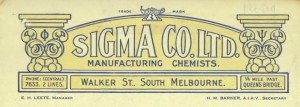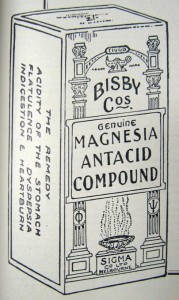Ernest Holloway Leete was a prominent chemist who was a member of the College of Pharmacy who had established his own pharmacy in 1897. The entrepreneurial Leete had been part of a move in 1904 among a group of commercially-minded chemists to put up proprietary preparations under a common label. Although that idea had failed at the time to gain momentum, Leete remained keen on the initiative. The concept was an elegant variation on what the ‘friendly societies’ were offering at the time to its members, both benefiting its members as well as benefiting society at large. Leete decided to pursue the idea himself, but realised that he needed an organisation to be its sponsor. At that time, in 1912, about the only active body on the trading side of pharmacy was the South Suburban Chemists’ Association. Leete approached the association with his proposal.
The South Suburban Chemists’ Association was an informal grouping of pharmacists from the suburbs south of the River Yarra, who had banded together for mutual benefit in 1883. In this time, many medicines were literally ‘manufactured’ in garages and homes of chemists although larger laboratories were being established. Leete himself operated his compounding pharmacy activities from his home and pharmacy at 3 Claremont Avenue, Malvern.
Leete’s opportunity to put forward his ideas was approaching. In Melbourne by 1912, some pharmacists were becoming alarmed at the high prices being charged by wholesalers for some drugs and manufactured medicines. To retail these products at a price that the market would bear, the pharmacist’s own profit margins were being steadily eroded. The association was therefore open to Leete’s idea – if they could manufacture and package proprietary medicinal, household, galenical (natural) and toilet preparations for exclusive sale by pharmacists they could, in theory, compete with the price monopoly of the wholesalers.
In March 1912, at a meeting of association members at the Star Hotel, Prahran, he suggested the new approach to the association. Being conservative by nature the association decided to try the business model out first. On 18 June 1912 the association, in a meeting at the College of Pharmacy, authorised Leete and his friend pharmacist Edwin Thomas Church to proceed. Based on their results, the association would decide whether to form a company later. The association gave its endorsement, but no cash. Leete and Church were to be remunerated with 1% of the revenue. They never did collect that, but rather put their own money into the start-up business to keep it alive.
The agreement with the association was simple – Leete and Church would proceed and if successful, hand over their personal interest and rights in the business to a new company, if formed. Their business approach was to seek ‘subscribers’ from about 420 pharmacists across Victoria. A circular, with postage paid for with £2 by Leete and Church, asked pharmacists to contribute £20 each and in return receive £40 of goods. At a later date, subscribers would be given a £1 share in the company, if formed, without payment. Only 80 or so responded, the remainder no doubt being somewhat suspicious of the new scheme. This response dismayed supporters in the association who even wanted the payments to be returned, but Leete and Church were not deterred. They pushed on and made arrangements to produce the first products.
The circular also requested suggestions for a name for the new enterprise; several were received but were disregarded. After some discussion of Greek alphabet letters, Leete and Church decided to call their enterprise ‘Sigma’. As Church had proposed ‘Delta’, it was agreed that the first trademark should contain the Greek letters for both ‘Sigma’ and ‘Delta’ superimposed on an ancient Egyptian lamp. The first cartons of product also introduced Greek Corinthian columns and general Grecian design. The Egyptian lamp design was still in use as a trademark as late as 1955.

The founders had a light-hearted approach to deciding the first product names. These included an antacid powder, for which the pharmacists purchased the ingredients, mixed the powder and packaged it in tins for sale under the name of ‘Bisby’. Leete later said that they made up the name from a mix of the initials of ‘Sigma Improves Your Bank Balance’. The next product was called ‘Seta’, in this case from the phrase ’Sigma extends throughout Australia’. Then ‘Saneta’, from ‘Sigma articles now extend throughout Australia’ (1915).

Although only small quantities of the first few lines were being produced, the business concept continued to grow in popularity and by the end of the first year there were over two hundred subscribers. On 3 June 1913, at a meeting of subscribers at the College of Pharmacy, it was agreed that a company could now be established, to be called Sigma Company Limited. Shares in the company would be issued at £1 each, with the nominal capital of the company set at £2,000. Shareholders were limited to 10 shares and only registered chemists in retail business could be shareholders. Church was appointed provisional chairman and Leete, provisional secretary, pending the first annual meeting to be held at the College of Pharmacy. The company was formally registered on 13 October 1913.

